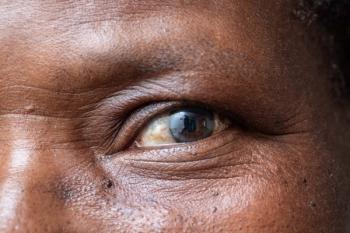
FILLY study crosses goal with drop in geographic atrophy
The results of the phase II FILLY study are in agreement with the prior literature on risk factors for GA progression.
The phase II FILLY study met its primary endpoint of statistically significant reduction in geographic atrophy (GA) lesion growth in eyes treated with the investigational complement factor 3 inhibitor, APL-2 (
Additional findings from a post-hoc analysis showed that over the 12-month study, the treatment benefit of APL-2 injections given monthly or every other month was maintained irrespective of the presence of select risk factors for GA progression, reported Eleonora Lad, MD, PhD, associate professor of ophthalmology,
Dr. Lad served as a principal investigator for the phase II FILLY Study at the
The FILLY study randomly selected 246 patients 2:2:1:1 to single-masked intravitreal treatment for 12 months, with APL-2 every month or every other month or sham every month or every other month.
RELATED CONTENT:
Eligibility
Patients were eligible for participation if they had BCVA ≥20/320 and a diagnosis of GA of the macular secondary to AMD with total GA area ≥2.5 and ≤17.5 mm2 and at least one focal lesion ≥1.25 mm2 if the GA was multifocal.
The analyses presented by Dr. Lad evaluated the impact of select baseline characteristics on progression of GA at month 12 in the FILLY study. Variables examined as potential predictors of GA progression included clinical and functional features that have been well-described as prognostic factors in the literature-lesion size, multifocality, location, low luminance deficit, and presence of reticular pseudodrusen -as well as patient demographics.
The data showed that, in general, benefit of APL-2 over sham was observed regardless of patient age, gender, baseline GA characteristics, baseline BCVA, and baseline low-luminance deficit.
Multivariable analyses identified two key risk factors for GA progression: 1) baseline GA lesion location and 2) baseline low-luminance deficit.
Treatment effect with APL-2 remained statistically significant when the population was controlled for these two key risk factors.
“These results are in agreement with the prior literature on risk factors for GA progression,” said Dr. Lad, who also is director of grading, Duke Reading Center. “This is an important finding, as it conclusively demonstrates that the FILLY study population was a typical GA population.”
RELATED CONTENT:
Reducing GA growth
In addition, the fact that APL-2 was beneficial in reducing GA growth, after controlling for the key risk factors for GA progression in the multivariable analysis, further reinforces the positive results from the FILLY study.
“Note that baseline BCVA dropped out as a prognostic variable, which illustrates the power of doing a multivariable analysis,” Dr. Lad explained.
Dr. Lad also commented on the strengths and limitations of the research she presented.
“The strengths are that the data come from a relatively large, prospective phase II study, in which GA progression was evaluated by an independent reading center in a masked fashion and in which visual acuity was measured by masked examiners,” she said. “Its limitations include the fact that it is a post-hoc analysis and there were small sample sizes in the subgroups.” Dr. Lad noted that because of the positive results in FILLY, two phase III studies are now underway evaluating APL-2 as a treatment for GA associated with age-related macular degeneration.
Disclosures:
Eleonora Lad, MD, PhD
E: [email protected]
This article was adapted from Dr. Lad’s presentation at the at the 37th annual scientific meeting of the American Society of Retina Specialists. Dr. Lad is a scientific advisor to and receives research funding from Apellis and other companies that are developing treatments for dry age-related macular degeneration.
Newsletter
Don’t miss out—get Ophthalmology Times updates on the latest clinical advancements and expert interviews, straight to your inbox.



















































.png)


